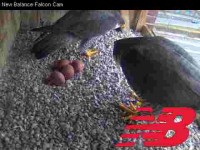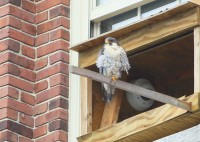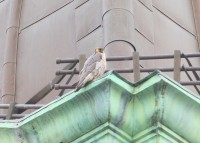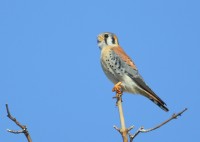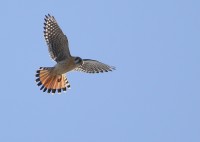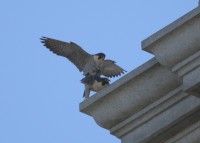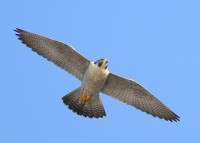American Kestrel: nesting?
March 30, 2012 in Nearby Landbirds
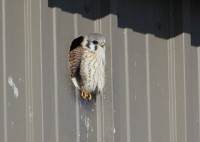 Encountered this American Kestrel on Tuesday morning in Lawrence. This location has supported nesting Kestrels in the past few years according to a local observer. What a delight to see this kestrel perched in the cavity opening after keeping an eye out for the past few weeks! According to Mass Audubon, “spring migration occurs mainly during March and April, and by the latter month local breeders are on their territories at woodland borders, fields, pastures, and the edges of highways. As the breeding season approaches, kestrels abandon their solitary winter habits. Members of a pair often perch side by side, and courtship consists of aerial displays by the male above a perched or flying female. The male ascends on rapidly fluttering wings and then plunges steeply, giving the familiar, repetitive killy-killy or kee-kee call, which is used not only in courtship but also at other times of excitement. Copulation during this period is frequent and precedes egg laying by several weeks.”
Encountered this American Kestrel on Tuesday morning in Lawrence. This location has supported nesting Kestrels in the past few years according to a local observer. What a delight to see this kestrel perched in the cavity opening after keeping an eye out for the past few weeks! According to Mass Audubon, “spring migration occurs mainly during March and April, and by the latter month local breeders are on their territories at woodland borders, fields, pastures, and the edges of highways. As the breeding season approaches, kestrels abandon their solitary winter habits. Members of a pair often perch side by side, and courtship consists of aerial displays by the male above a perched or flying female. The male ascends on rapidly fluttering wings and then plunges steeply, giving the familiar, repetitive killy-killy or kee-kee call, which is used not only in courtship but also at other times of excitement. Copulation during this period is frequent and precedes egg laying by several weeks.”
